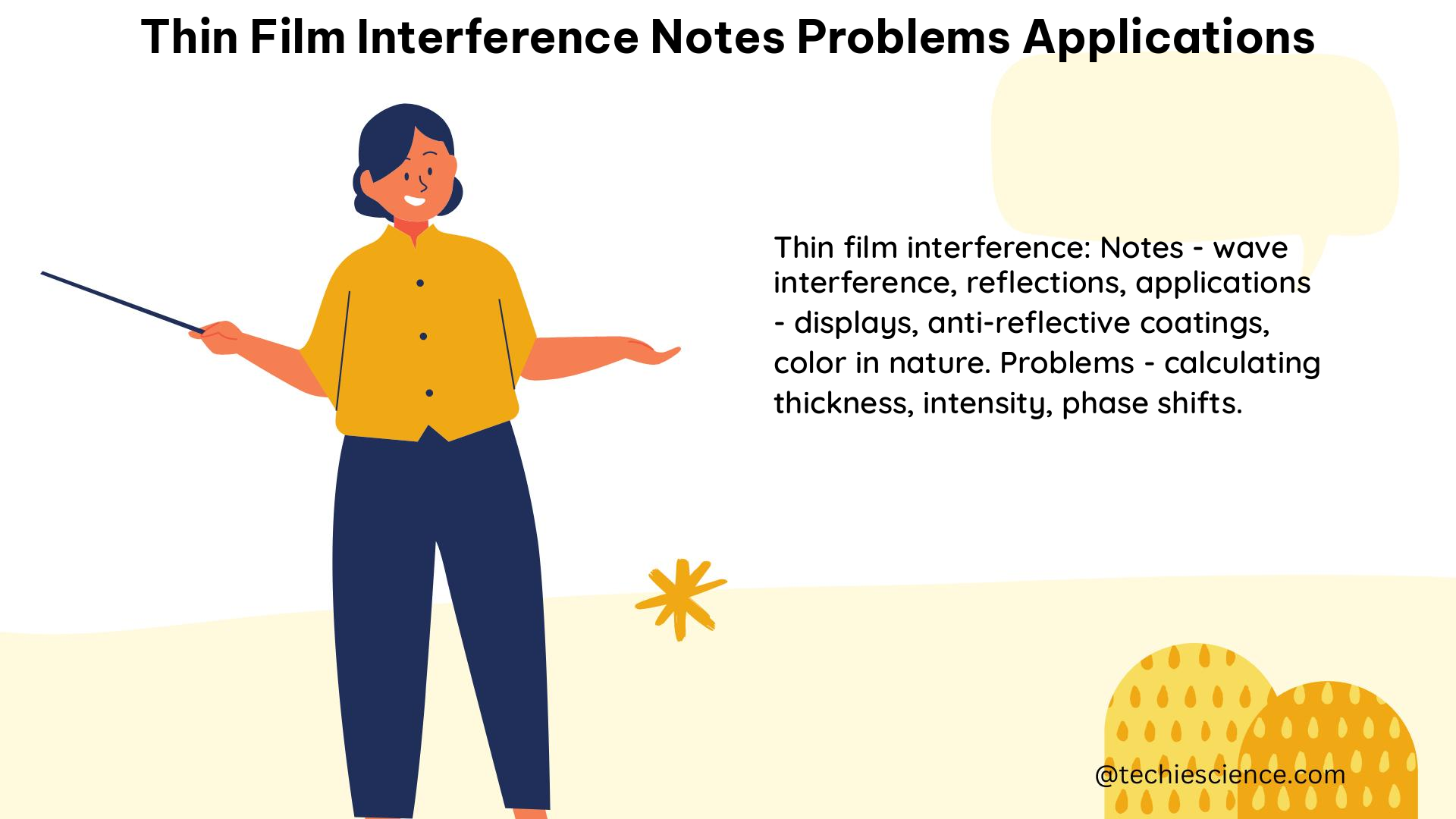Thin film interference is a fascinating optical phenomenon that occurs when light interacts with a thin, transparent film. This effect has numerous practical applications, from the vibrant colors of soap bubbles to the anti-reflective coatings on camera lenses. In this comprehensive guide, we’ll delve into the underlying principles, explore various problems and their solutions, and uncover the diverse applications of thin film interference.
Understanding Thin Film Interference
Thin film interference arises when light reflects off the top and bottom surfaces of a thin, transparent film. The reflected light waves can either constructively or destructively interfere, depending on the wavelength of the light and the thickness of the film.
The condition for constructive interference is given by the equation:
mλ = 2nT cos(θ)
where:
– m is an integer representing the order of interference (0, 1, 2, …)
– λ is the wavelength of the light in the medium
– n is the refractive index of the film
– T is the thickness of the film
– θ is the angle of incidence of the light
When the path difference between the two reflected waves is an integer multiple of the wavelength, constructive interference occurs, and the reflected light is amplified. Conversely, when the path difference is an odd multiple of half the wavelength, destructive interference occurs, and the reflected light is canceled out.
Thin Film Interference Problems

Solving thin film interference problems involves applying the principles of wave optics and using the equation mλ = 2nT cos(θ). Here are some examples of common problems and their solutions:
Problem 1: Determining Film Thickness
Given the wavelength of light, the refractive index of the film, and the order of interference, calculate the thickness of the thin film.
Solution:
Rearranging the equation, we get:
T = (mλ) / (2n cos(θ))
For example, if the wavelength of light is 550 nm, the refractive index of the film is 1.5, and the order of interference is 2, the thickness of the film would be:
T = (2 × 550 nm) / (2 × 1.5 × cos(0°)) = 733.3 nm
Problem 2: Determining Wavelength of Constructive Interference
Given the thickness of the thin film, the refractive index, the order of interference, and the angle of incidence, calculate the wavelength of light that will experience constructive interference.
Solution:
Rearranging the equation, we get:
λ = (2nT cos(θ)) / m
For example, if the film thickness is 500 nm, the refractive index is 1.4, the order of interference is 3, and the angle of incidence is 30°, the wavelength of constructive interference would be:
λ = (2 × 1.4 × 500 nm × cos(30°)) / 3 = 577.4 nm
Problem 3: Determining Angle of Incidence
Given the wavelength of light, the refractive index of the film, the order of interference, and the thickness of the film, calculate the angle of incidence for constructive interference.
Solution:
Rearranging the equation, we get:
θ = cos^-1((mλ) / (2nT))
For example, if the wavelength of light is 600 nm, the refractive index of the film is 1.6, the order of interference is 2, and the thickness of the film is 400 nm, the angle of incidence for constructive interference would be:
θ = cos^-1((2 × 600 nm) / (2 × 1.6 × 400 nm)) = 53.1°
Applications of Thin Film Interference
Thin film interference has a wide range of applications in various fields, including optics, materials science, and engineering. Here are some notable examples:
Measurement of Thin Film Thickness
As mentioned earlier, thin film interference can be used to measure the thickness of thin films. By analyzing the interference color patterns in an image captured by a color camera with three-wavelength illumination, the film thickness distribution can be estimated. This method is useful for non-destructive testing and quality control in industries such as semiconductor manufacturing and thin film deposition.
Anti-Reflective Coatings
Thin film interference is the basis for the design of anti-reflective coatings on lenses and other optical surfaces. By carefully choosing the thickness and refractive index of the coating, the reflection of light can be minimized, resulting in improved image clarity and contrast. This is particularly important in camera lenses, where multiple lenses are used, and reflections can degrade image quality.
Decorative Coatings
The vibrant colors observed in soap bubbles, butterfly wings, and some gemstones are a result of thin film interference. The specific colors are determined by the thickness and refractive index of the thin film. This phenomenon is exploited in the design of decorative coatings, such as those used in architectural glass, jewelry, and various consumer products.
Optical Filters
Thin film interference can be used to create optical filters that selectively transmit or reflect specific wavelengths of light. These filters have applications in various fields, including astronomy, photography, and telecommunications, where they are used to isolate specific wavelength bands or suppress unwanted light.
Sensing and Monitoring
Thin film interference can be used as a sensing mechanism in various applications, such as the detection of small changes in film thickness, refractive index, or surface properties. This principle is employed in sensors for monitoring environmental conditions, chemical processes, and biological systems.
Conclusion
Thin film interference is a fascinating optical phenomenon with a wide range of practical applications. By understanding the underlying principles, solving relevant problems, and exploring the diverse applications, we can gain a deeper appreciation for the versatility and importance of this phenomenon in science and technology. Whether it’s the vibrant colors of a soap bubble or the anti-reflective coatings on our camera lenses, thin film interference continues to captivate and inspire us.
References:
- Thin Film Interference Jennifer Whetter | PPT – SlideShare. (2015-03-22). Retrieved from https://www.slideshare.net/slideshow/thin-film-interference-jennifer-whetter/46153092
- How to Solve Thin Film Interference Problems in Physics – YouTube. (2023-05-02). Retrieved from https://www.youtube.com/watch?v=iG18FO71R3w
- Thin-film thickness profile measurement by three-wavelength interference color analysis. (2024-05-14). Retrieved from https://www.researchgate.net/publication/236097136_Thin-film_thickness_profile_measurement_by_three-wavelength_interference_color_analysis
- Thin Film Interference | Physics – Lumen Learning. Retrieved from https://courses.lumenlearning.com/suny-physics/chapter/27-7-thin-film-interference/
- Application of thin-film interference coatings in infrared reflection … (1985-05-01). Retrieved from https://opg.optica.org/ao/fulltext.cfm?uri=ao-50-9-c301